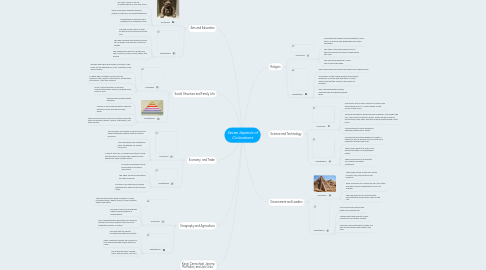
1. Religion
1.1. Sumerians
1.1.1. Mesopotamian religion was polytheistic, more than 2,000 gods and goddesses have been identified.
1.1.2. The chief of the gods varied from to period to period and every village had its own god.
1.1.3. The overriding purpose of man was to serve the gods.
1.2. Shang/Zhou
1.2.1. They would sacrifice humans and even bury children alive.
1.2.2. The leaders of the Shang dynasty would write questions on bones and heat them. Priests would interpret the cracks in the bones as answers.
1.2.3. They had polytheistic religion meaning they worshiped multiple gods.
2. Science and Technology
2.1. Sumerians
2.1.1. Astronomy was a major branch of science and they worked out a 12-month based on the cycles of the moon.
2.1.2. Some technological advances were irrigation, the plough, the sail, clay bricks, the potters wheel, metal-working, writing, accounting, filing, glass and lamp making, weaving and much more.
2.1.3. Mesopotamian scribes produced detailed mathematical tables.
2.2. Shang/Zhou
2.2.1. Had bronze and stone weapons to fight in battles as well as bronze armor for the more important soldiers like lords.
2.2.2. They made chariots to aide in war which gave them an advantage in battle.
2.2.3. They used bronze to make pots for cooking and other containers.
3. Government and Leaders
3.1. Sumerians
3.1.1. The temple stood at the very center of public life, both political and religious.
3.1.2. Each Sumerian city formed its own city-state and were fiercely independent from one another.
3.1.3. The king was held to be the earthly representative of the patron god of the city.
3.2. Shang/Zhou
3.2.1. Had courtrooms paid by the people to organize law.
3.2.2. Leaders were high priests as well as political and military leaders.
3.2.3. Metal was associated with royalty and they buried leaders with bronze and jade.
4. Arts and Education
4.1. Sumerians
4.1.1. The main forms of art are sculpted figures in clay and stone.
4.1.2. These sculptures depicted animals, mythical creatures, and gods/goddesses.
4.1.3. Mesopotamian temples were designed to a rectangular plan.
4.2. Shang/Zhou
4.2.1. The Zhou made many of their art pieces from bronze and fired clay.
4.2.2. The Zhou dynasty had private schools set up where scholars like Confucius taught.
4.2.3. The Shang were skilled in using bone, jade, ceramics, stone, wood, shells, and bronze.
5. Social Structure and Family Life
5.1. Sumerians
5.1.1. Women had rights and duties as citizens, they could act as witnesses in court, and they could own property.
5.1.2. A father had complete control over his children's lives, even to the point of selling them into slavery, until they married.
5.1.3. Most of the population in ancient Mesopotamia were farmers, working small plots of land.
5.2. Shang/Zhou
5.2.1. Farmers were almost always peasants.
5.2.2. Nobles of the Shang dynasty fought on chariots in wars and wore bronze armor.
5.2.3. Their social structure from top to bottom was the king, the military nobility, priests, merchants, and then farmers.
6. Economy and Trade
6.1. Sumerians
6.1.1. The economy was based on agriculture and temples/palaces retained huge economic influence.
6.1.2. Food surpluses and craft goods were exchanged for mineral resources.
6.1.3. In about 3000 BC, an added incentive to trade was the desire to acquire the copper and tin needed to make valuable items.
6.2. Shang/Zhou
6.2.1. Economy was based on the production and trade of agriculture.
6.2.2. The Zhou economy was based on trade of goods.
6.2.3. The Zhou circulated good mostly between gifts and tributes to each other.
7. Geography and Agriculture
7.1. Sumerians
7.1.1. The Mesopotamians grew a variety of crops, including barley, wheat, onions, turnips, grapes, apples and dates.
7.1.2. The rivers Tigris and Euphrates made farming possible in Mesopotamia.
7.1.3. The Mesopotamians were the first people to attempt to control water by the use of an integrated system of canals.
7.2. Shang/Zhou
7.2.1. The land that the Shang occupied was extremely fertile.
7.2.2. Their civilization was by the Haung He river which gave them their water for crops.
7.2.3. The Shang primarily farmed millet, wheat, barley, and rice.
